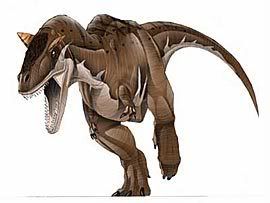Post by Barry the Baryonyx on Aug 26, 2007 14:12:45 GMT -5
Carnotaurus

copyright @ Jurassic Park Institute
Carnotaurus (kahrn-oh-TAWR-us) meaning "meat-eating bull", referring to its distinct bull-like horns (Latin carn = flesh + taurus = bull) was a large predatory dinosaur, with horns vaguely resembling a bull's.
Carnotaurus lived in Patagonia, Argentina during the Maastrichtian stage of the Late Cretaceous, and was discovered by José F. Bonaparte, who has discovered many other bizarre South American dinosaurs.
Description
Carnotaurus was a medium-sized theropod, about 9.0 m (30 ft) in length, 3.5 m (10 ft 7 in) tall at the hips, and weighing about 1,600 kg (1.76 tons). The most distinctive features of Carnotaurus are the two thick horns above the eyes, and the extremely reduced forelimbs with four fingers. It had a small skull, a thick chest, and a thin tail. The eyes of the Carnotaurus faced forward, which is unusual in a dinosaur, and may indicate binocular vision and depth perception.
A single nearly complete skeleton has been described including impressions of skin along almost the entire right side, that show Carnotaurus lacked feathers, unlike the more advanced coelurosaurian theropods (see also feathered dinosaurs). Instead, the skin is lined with rows of bumps, that become larger toward the spine.
The type species Carnotaurus sastrei is the only known species. Its closest relatives include Aucasaurus (Argentina), Majungatholus (Madagascar), and Rajasaurus (India). Together, these dinosaurs form the subfamily Carnotaurinae in the family Abelisauridae. Among the carnotaurines, Carnotaurus is most closely related to Aucasaurus, and together these two genera form the tribe Carnotaurini.
Copyright © 2007 Answers Corporation


 Is it just us?
Is it just us?